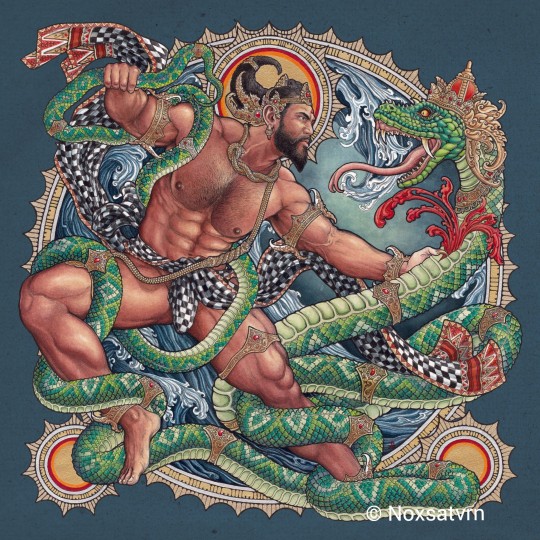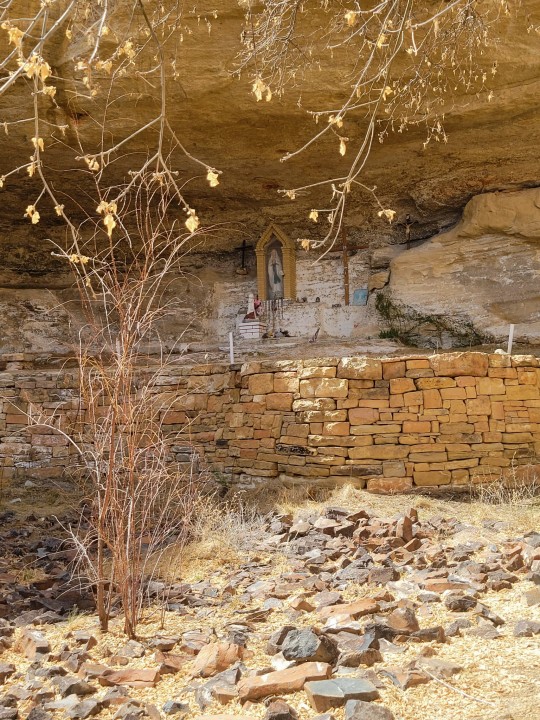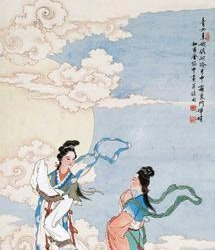#folk religion
Text

#mari lwyd#Welsh#welsh folklore#wales#christmas#folklore#england#British#english folklore#folk religion#uk#ritual
320 notes
·
View notes
Text

Wrekodara and the Sea Serpent.
Ink, watercolor & colored pencils on paper.
© noxsatvrn
The artwork depicts one scene from Serat Dewaruci, a narrative poem by Yasadipura I, the royal poet of Kasunanan Surakarta based on an even older text, Nawaruci, by a hindu priest Mpu Çiwamurti.
Wrekodara, also known by the name Bhima and Sena is a figure from the Hindu Epic Mahabharata. The 2nd eldest of the five Pandawa born ritualistically through the blessing of Lord Vayu, short-tempered yet kind and compassionate he's the strongest one among his siblings.
In the Pre-islamic Java, Wrekodara was adored by the common folk especially in the agriculture community as he was venerated as the symbol of masculinity and fertility, proven by many archaeological findings of ancient statues depicting Wrekodara. Traditions and myths surrounding Wrekodara persists to this day through the tradition of Wayang Kulit (Javanese shadow puppetry) telling stories about him during harvest festivals in several remote villages as well as the myth about the origin of a sacred spring near Dieng Highlands called Tuk Bima Lukar.
#art#gay artist#ink#watercolor#art nouveau#male muscle#muscle men#hairy male#noxsatvrn#mythology#folklore#paganism#folk religion
360 notes
·
View notes
Text

Traditional Chinese Catholic depiction of the Nativity scene
#chinese folklore#folk religion#Chinese Catholic#Catholicism#Asian#chinese painting#religious art#folk catholicism#folk Catholic#nativity
41 notes
·
View notes
Text
I love you dog saint Guinefort I love you Santa Muerte I love you Maria-Kannon I love you Damballa-Moses I love you folk traditions that the Vatican hates I love you the beautiful and inevitable diversity of any religion that tries to globalize
105 notes
·
View notes
Text

Current Altar to Our Lady Mary.
Queen of Heaven & Queen of my Heart 🖤
#altars#altar ideas#altar#folk christianity#folk catholicism#blessed virgin mary#oceannotfound blogs#oceannotfound posts#rosary#religon#religious#folk religion#cunning folk#queen of heaven#queen of the heavens#rose lineage#the goddess#goddess religion#mother goddess#goddess worship#paganism#catholic witch#mother mary#st michael#queen of angels#angel work#eclectic witch#eclectic pagan#eclectic wicca#mary deity
28 notes
·
View notes
Text
youtube
When your favorite influencer says that the Christmas tree originates from pre-Christian Germanic paganism, they're inadvertently parroting ideas ideas invented without evidence by nineteenth century German nationalist writers […] In fourteenth century Alsace, peasants were apparently gathering branches from the forests around Christmas time; possibly to decorate their houses. By the fifteenth century, people in this region were setting up and decorating Christmas trees and maypoles. This much is firmly established; but it's a huge leap to call this a pre-Christian folk custom. Our earliest Christmas tree is 1419, hundreds of years after the Christianization of the region, and the practice appears somewhat suddenly in history. There is no chain of evidence that could link this practice to ancient or late ancient practice. Rather, it seems to emerge from Christian communities to celebrate a Christian holiday.
46 notes
·
View notes
Text
Russian Peasants & Religion

Russian Peasants, late 19th century.
The religiosity of the Russian peasant has been one of the most enduring myths -- along with the depth of the Russian soul -- in the history of Russia. But in reality the Russian peasant has never been more than semi-detached with the Orthodox religion. Only a thin coat of Christianity had been painted over his ancient pagan folk-culture.
To be sure, the Russian peasant displayed a great deal of external devotion. He crossed himself continually, pronounced the Lord's name in every other sentence, regularly went to church, always observed the Lenten fast, never worked on religious holidays, and was even known from time to time to go on pilgrimage. to holy shrines.
Slavophile intellectuals, like Dostoevsky or Solzhenitsyn, might wish to see this as a sign of the peasant's deep attachment to the Orthodox faith. And it is certainly true that most of the peasants thought of themselves of Orthodox. If one could go into a Russian village at the turn of the century and ask its inhabitants who they were, one would probably receive the reply: 'We are Orthodox and from here.'
But the peasants' religion was far from the bookish Christianity of the clergy. They mixed pagan cults and superstitious magic and sorcery, with their adherence to Orthodox beliefs. This was the peasants' own vernacular religion shaped to fit the needs of their precarious farming lives.
A People's Tragedy: The Russian Revolution, 1891–1924, Orlando Figes
#Russian History#History#Folk culture#folk religion#Imperial Russia#Tsarist Russia#orthodox christianity
38 notes
·
View notes
Text
i find the Fairy Vs Walrus thing really funny because, in my culture, fairies & other mythological creatures are seen as legitimately just a real thing we live alongside already & work with regularly, & so if i opened the door & saw a fairy, i would legit just be like "Hello :) what are you here for?" with no real surprise, & this is so normal to me that it is legit surprising to see how many people wholeheartedly don't believe in them, like, i know it's just cultural differences & stuff but it's surprising & interesting to see
#faerie#fae#fairies#fairy#walrus#fairy vs walrus#meme#pagan#mythical creatures#mythology and folklore#folklore#folk religion#to be clear#i am not saying you have to believe in them#just that i do & that is normal in my culture
21 notes
·
View notes
Text
As someone who grew up in the south and moved to northern Midwest it was strange to see how different the devil is treated in each one'sfolklore
In the South the devil is someone you know. The devil did go down to Georgia. I know becase I saw him there. I saw the devil that signed that contract. And so on
The devil is an outside force trying to trick someone who was otherwise good to feed into their worst impulses.
But up there The devil is inside of you a part of you that you should constantly push your way. The devil is the cold in your bones testing what you will do for warmth.
24 notes
·
View notes
Photo

Predominat religion in every country.
by indiatour__
#maps#world#countries#christianity#islam#hinduism#buddhism#judaism#folk religion#shintoism#symbol#religions
372 notes
·
View notes
Text
I really don't know if I'm even talking about the same thing as other people here on tumblr when I talk about magic, cause when I think of it, I think mostly of "folk magic". The magic of everyday cultural traditions, the stuff that is often branded "superstition".
I don't know what makes people think that you need any special preparation or education or training in order to do all this stuff. There's nothing secret about it, and nothing complicated. And unless you engage in behaviors that physically/mentally harm you, I don't see what dangers could possibly be involved.
But also I think people overcomplicate the whole thing. You don't need any sort of special tools. You don't need to spend money on any of this. Literally all you need is the knowledge of what you're trying to achieve and a clear idea of what you are trying to practice. And please, let's stop acting like "trivial" activities are excluded from this. The same goes for what you desire to achieve with these activities. Nothing is too trivial of a need/desire. You are hoping for the bus to arrive on time tomorrow? That's a perfectly fine thing to want out of whatever you're about to practice!
I think as a whole, the pagan community needs to get their heads out of the clouds a bit and ground themselves and their practices. As cliche as it sounds, y'all need to touch more grass again. It's a hands-on spirituality, after all.
And genuinely, the gatekeeping and mystification of it all has to stop. There's no secrets, no exclusivity, no sacrilege, no entry barriers in paganism, no scholars, and no knowledge is off-limits.
It's the religion of the common folk. You do not need to read any books about it, you don't need anyone to interpret for you, or follow anyone's directions on how to practice this or that. And if you feel like there's nothing tangible about your paganism, if you find yourself having to believe in things rather than simply experiencing them.... it's time to ask yourself who indoctrinated you with such ideas.
#paganism#heathenry#religion#animism#magic#folk magic#folk religion#the eddas are overrated fanfiction written by christians#and too many people fall for esoterics#I'm sorry to be so blunt but why are so many of y'all so fixated on purely metaphysical things to the point of detaching them entirely#from their physical context?#once again feeling like the wiccan movement gave people many weird ideas#just my two cents as usual
53 notes
·
View notes
Text

Visited a beautiful shrine today.
8 notes
·
View notes
Text
Chinese Folk Religion: Snowy edition
Recent snow storms where I live has got me thinking: is there a deity responsible for snowfall and winter in traditional Chinese religion?
You got Frau Perchta/Holle in Germanic folklore, Yuki-Ona in Japanese Shinto folk beliefs, Skadi in Norse Paganism, and Morana in Slavic mythology, but I haven't ever heard of such a figure from my elders growing up.
So for this one, I had to actually use my limited Mandarin skills to do research, along with some help from more fluent family members and friends.
It turns out there are more than one traditional winter & snow deities in Chinese folklore. The reason I personally didn't hear of any is because, again, Chinese folk religion is extremely regional. There are central major deities that are uniform but the rest all differs from region to region. Han Chinese people have always spread out across several climate zones, from tropical to sub-arctic. Understandably, Gods and Goddesses associated with weather will differ from region to region. My Chinese side of the family hailed from a region where snowfall isn't very common, and winter isn't normally extreme. But look towards regions north of the Yellow River, and it's more upstream valleys in the Han Chinese heartland, it's a different story.
Teng'Liu: The Spirit of Snow and Frost
The first deity I can find is a figure named Teng'Liu (藤六). This is a male deity associated with snow itself. The "Liu" part if his name is the Chinese character for 6. Snowflakes typically have six arms/branches regardless of pattern. In Chinese numerology, the number 6 is also a number with "extreme Yin energy" (极阴). Snow itself is a thing with a lot of Yin energy too, as it's formed from water. Those familiar with Chinese cosmology should be familiar with the element's association with the cardinal direction of North. Which, again, is attributed with Yin. Thus explains why many forms of his folk names contains the number 6.
There is a folk ritual (which thankfully hasn't been practiced in over a century), which in Northern villages they used to offer up a young girl to this snow deity as a gift to appease him. The unfortunate girl would be tied up in a sack and left to the elements in the cold.
Teng'Liu occurs often in poetic works of literature as a stand-in for "snow". A fitting example is a work from Song dynasty writer and poet Yang Wanli, where he mentions "The Azure Lady pulls along Teng'Liu, as the Sun wilts away as she shakes (him)"** The meaning is obvious, but he mentions an Azure Lady, which takes us to another deity.
Qing'nu (青女): The Azure Lady
The second deity associated with snow and winter is a Goddess called Qing'nu, or "The Azure Lady", "The Lady in Turquoise", "The Lady in Blue", depending on the translation. She seems to be much more well-attested in ancient religious texts in addition to poetry and seems to predate the emergence of Teng'liu.
Attested in Huainanzi, a text compiled around 139 BC, "...three moons into autumn, Qing'nu emerges (from her home), and makes frost and snow fall..."
She is also mentioned as having white hair in a lot of classical Chinese poetry.
In traditional Chinese folk beliefs, Qing'nu resides in the moon and is a companion/handmaiden of the Moon Goddess Chang'E (嫦娥). Every year at the end of autumn, she will emerge from the moon palace to perform her duty: to bring winter, frost, cold, and snow. She will descend upon Mount Qing'yao (青要山), where she will bathe in the waters there to purify herself. She will then start playing her seven-stranded lyre and snow and frost will fall upon the earth to cleanse the land of impurities and diseases (until they come back next summer).
BTW Mt. Qing'yao is an actual mountain in Henan Province. The mountain itself does play a rather big role in traditional beliefs and in Taoism. In fact, there is a hill adjacent to the mountain named Qing'nu's Peak (青女峰), where on the peak there stands a pillar-like rock. In local folklore they say that lone pillar looks like a slender lady, standing atop the mountains looking down upon the earth. It marks where the Goddess herself stands every year to bring winter. The locals call it "the maiden's rock" (闺女石).
Legend has it there was once a gorgeous palace at the foot of this mountain where Qing'nu would stay in temporarily during winter. This could possibly be a reference to some type of structure used as a shrine or temple. Today only the spring that flowed in the palace remain. The very spring that, according to folklore, that the Goddess herself bathes in to purify herself. Today, young ladies from around would make pilgrimage to that spring to welcome her arrival on 14th day of the ninth month. A second pilgrimage would also be made on 13th day of the third month as she is supposed to leave and return to the moon. (the dates are the dates in the Chinese lunar calendar).

From these we can see while those deities are all associated with snow, they are seen by the people as very different. Teng'liu is very embodiment of the weather phenomenon, kind of like Jack Frost in American folklore. The fact there were rituals to appease him means that he is seen as a very unpredictable and volatile force. A spirit which has to be controlled under strict orders from a higher Celestial deity (天神): Qing'nu. Think of her as the Chinese counterpart to Frau Holle, a spirit attributed to making snow fall but not the snow itself. Or rather, think of those two like Helios and Apollo in Greco-Roman mythology. One being the sun itself and the latter being the one who pulls the sun across the sky.
This was fun, i hope all you folks who are trying to connect to their ancestral beliefs found this useful.
**translation might be off, sorry. Middle Chinese is difficult even for fluent speaker who studies old literature, plus this was Middle Chinese in it's poetic form.
#chinese folk religion#folklore#chinese folklore#history#ancestors#witchblr#witches of color#han chinese#chinese diaspora#folk taoism#chinese mythology#chinese religion#folk religion#polytheism#world religions
52 notes
·
View notes
Text
My brain's rambling around in my head today (because someone went through my Mormon Folk Healing tag and left a bunch of notifications last night); thinking about how you can't really be a Folk Healer without a community of people to heal to begin with, and how certain people are so right about the "Folk" element of so much of Folk Religion and Folk Magic really referring not only to the fact these practices are deviating from the standard of the culture, but also to the presence of a collective community to service with these skills in the first place- rather than that pseudo-spiritual nonsense about it referring to "its connection to the Earth", or "the fact it's low magic", and the nonsense about "living on the edge, alone and an othered outcast".
15 notes
·
View notes
Text
Im baptised Anglican. But it wasn't ever about the Church.
It was about me. The Holy Spirit. Sophia. Jesus.
About me finding myself. About learning /attaining Gnosis. About seeing God, the Gods, in my own way. It was about Marian Consecration. About love and peace.
*not* the church.

#christo pagan#christopagan#christopaganism#holy mother#god the mother#great mother#great goddess#folk catholicism#english folklore#folk religion#english folk magic#queer anglican#lgbt anglican#gay anglican#anglican#lgbtq community#lgbt christian#gnostic gospels#gnostic christianity#gnosticism#sophia#holy sophia#oceannotfound posts#oceannotfound blogs
25 notes
·
View notes
Text

The famed Rabbi Abraham Joshua Heschel, here pictured with his daughter Susannah, now Distinguished Professor of Jewish Studies at Dartmouth College. Rabbi Heschel passed away on December 23rd, 1972 (on the Sabbath) - today is the 51st anniversary of his death (and also the Sabbath). זיכרונו_לברכה
On my father's last Shabbat we had a wonderful dinner with many friends, after which one of our guests read aloud some of my father's Yiddish poems, written when he was a young man. He went to sleep that night and never woke. In Jewish tradition, dying in one's sleep is called a kiss of God, and dying on the Sabbath is a gift that is merited by piety. For the pious person, my father once wrote, it is a privilege to die.
- Susannah Heschel, in her introduction to her father's book, The Sabbath.
24 notes
·
View notes